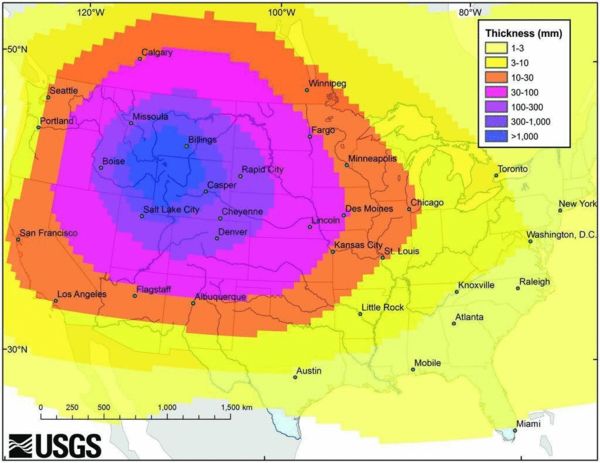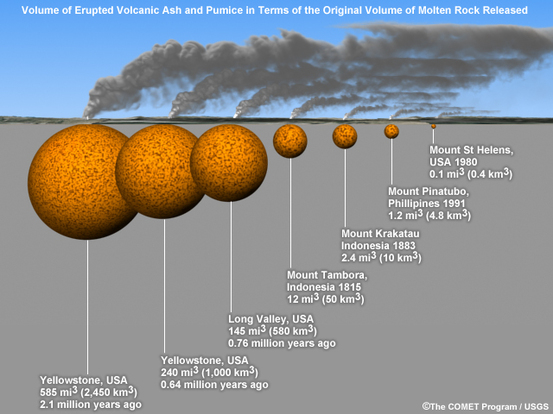This Is What Would Happen If The Yellowstone Supervolcano Erupted
Sep 9, 2014 23:12:08 #
This Is What Would Happen If The Yellowstone Supervolcano Erupted
Business Insider By Ajai Raj
Recently, rumors have been swelling of a danger at Yellowstone National Park. That danger? A brewing supervolcano eruption.
The fear of a Yellowstone supereruption, which ultimately went viral, may have begun back in February when a seismometer called B944 began sending senseless data to a public viewer at the University of Utah's seismographic station, as George Black reports in The New Yorker.
Luckily for most of the U.S., the likelihood this eruption would happen is pretty low: about one in 100,000 any given year. If it did happen, it would be pretty devastating, though.
Supervolcano = super danger
The danger of these eruptions isn't just lava in the area around the volcano the ash alone poses a serious threat. Breathing hot ash can result in respiratory burns, and the minerals it contains can irritate the skin and cause abrasions in the eyes and the respiratory system. The pileup of ash on rooftops has resulted in building collapses, and ash accumulation on streets can make roads dangerous, if not impossible, to navigate. And ash in the sky disrupts air travel by blocking visibility and interfering with electronics.
The following map show a simulated distribution of volcanic ash if Yellowstone were to erupt to its full potential. The scale is in millimeters, 25.4 of which make up an inch. So people in the purple area would be coated with more than an inch of ash, while people in the blue areas would find themselves buried in it:
View gallery
.yellowstone ash map
United States Geological Survey
A simulation of the possible distribution of ash from a Yellowstone supereruption
In short, a Yellowstone supereruption would disrupt electronics and endanger human health in Montana, Idaho, Wyoming, and affect other parts of the country. Moreover, a month-long supereruption could affect the global climate for years, even decades.
When will it happen?
Fortunately, it's also extremely unlikely to happen anytime soon, despite a lot of apocalyptic handwringing to the contrary.
"Thinking about a Yellowstone supereruption is like imagining a large asteroid hitting the Earth," says Jacob Lowenstern, a research geologist with the USGS and Scientist-in-Charge of the Yellowstone Volcano Observatory. "It could happen, but it's not something you can plan for or worry about, because it's such a low-probability event."
View gallery
.yellowstone lava flows
United States Geological Survey
Post-caldera lava flows at Yellowstone Volcano.
In fact, Yellowstone hasn't erupted at all for 70,000 years, and the probability of a supereruption in any given year is somewhere between one in 100,000 and one in a million, according to Lowenstern. "The most likely thing to happen when it does erupt is a moderate eruption with a minimal effect outside of Yellowstone."
While there are gaps in our volcano monitoring program, we are better off focusing our efforts on those that we can predict and prepare for smaller eruptions, Lowenstern says.
"If you have a regular eruption that puts sulfur into the atmosphere, it can affect the earths climate," he adds. "That's the kind of eruption that we should be thinking about."
Comments;
There are a couple of very nice graphics with this story, but I'm unable to copy them because they copy as HTML files. Well, I managed to get one of them after all.
Business Insider By Ajai Raj
Recently, rumors have been swelling of a danger at Yellowstone National Park. That danger? A brewing supervolcano eruption.
The fear of a Yellowstone supereruption, which ultimately went viral, may have begun back in February when a seismometer called B944 began sending senseless data to a public viewer at the University of Utah's seismographic station, as George Black reports in The New Yorker.
Luckily for most of the U.S., the likelihood this eruption would happen is pretty low: about one in 100,000 any given year. If it did happen, it would be pretty devastating, though.
Supervolcano = super danger
The danger of these eruptions isn't just lava in the area around the volcano the ash alone poses a serious threat. Breathing hot ash can result in respiratory burns, and the minerals it contains can irritate the skin and cause abrasions in the eyes and the respiratory system. The pileup of ash on rooftops has resulted in building collapses, and ash accumulation on streets can make roads dangerous, if not impossible, to navigate. And ash in the sky disrupts air travel by blocking visibility and interfering with electronics.
The following map show a simulated distribution of volcanic ash if Yellowstone were to erupt to its full potential. The scale is in millimeters, 25.4 of which make up an inch. So people in the purple area would be coated with more than an inch of ash, while people in the blue areas would find themselves buried in it:
View gallery
.yellowstone ash map
United States Geological Survey
A simulation of the possible distribution of ash from a Yellowstone supereruption
In short, a Yellowstone supereruption would disrupt electronics and endanger human health in Montana, Idaho, Wyoming, and affect other parts of the country. Moreover, a month-long supereruption could affect the global climate for years, even decades.
When will it happen?
Fortunately, it's also extremely unlikely to happen anytime soon, despite a lot of apocalyptic handwringing to the contrary.
"Thinking about a Yellowstone supereruption is like imagining a large asteroid hitting the Earth," says Jacob Lowenstern, a research geologist with the USGS and Scientist-in-Charge of the Yellowstone Volcano Observatory. "It could happen, but it's not something you can plan for or worry about, because it's such a low-probability event."
View gallery
.yellowstone lava flows
United States Geological Survey
Post-caldera lava flows at Yellowstone Volcano.
In fact, Yellowstone hasn't erupted at all for 70,000 years, and the probability of a supereruption in any given year is somewhere between one in 100,000 and one in a million, according to Lowenstern. "The most likely thing to happen when it does erupt is a moderate eruption with a minimal effect outside of Yellowstone."
While there are gaps in our volcano monitoring program, we are better off focusing our efforts on those that we can predict and prepare for smaller eruptions, Lowenstern says.
"If you have a regular eruption that puts sulfur into the atmosphere, it can affect the earths climate," he adds. "That's the kind of eruption that we should be thinking about."
Comments;
There are a couple of very nice graphics with this story, but I'm unable to copy them because they copy as HTML files. Well, I managed to get one of them after all.

Sep 9, 2014 23:48:44 #
Here's a graphic that shows the scale of the eruption
Gitzo wrote:
This Is What Would Happen If The Yellowstone Super... (show quote)

Sep 10, 2014 06:38:31 #
Sep 10, 2014 08:41:22 #
dljen wrote:
Hmmm, wonder where poor ol' godforsaken Indiana is? :)
Hoosiers have been wondering that same thing for many years. :lol: :lol: :lol:
Sep 10, 2014 08:43:49 #
Gitzo wrote:
This Is What Would Happen If The Yellowstone Super... (show quote)
I think if you check your facts the "70,000" years since the last eruption is actually 600,000 years. Seems the volcano is on that time-table. At this time it is running late. It is over-due!
Sep 10, 2014 08:57:44 #
davidrb wrote:
Hoosiers have been wondering that same thing for many years. :lol: :lol: :lol:
It's the big one, glitz, better grab your gun. Load up on bottled water and duct tape! :XD: :XD: :thumbup: :thumbup:
Sep 10, 2014 09:44:01 #
What do you mean "if" it erupts? It's not a matter of if, its a matter of when.
Sep 10, 2014 11:00:14 #
NDcanoe wrote:
What do you mean "if" it erupts? It's not a matter of if, its a matter of when.
:thumbup:
Sep 10, 2014 11:47:59 #
I read this book last year - a novel about what life would be like if Yellowstone erupted - very interesting:
Supervolcano: Eruption by Harry Turtledove
Supervolcano: Eruption by Harry Turtledove
Sep 10, 2014 12:53:08 #
treehugger
Loc: Eastern Idaho Highlands
I don't know it Yellowstone will explode in my life time or not. Just in case, my wife and I have developed a plan for when it does. At the first signs, we are going to hurry out into our front yard and watch. I figgure that we, at most, will only have one chance to see it, and that will only last for a couple of minutes,max..
Then---sputtxe we are gone.
Then---sputtxe we are gone.
Sep 10, 2014 16:27:53 #
RichieC
Loc: Adirondacks
The reason for the 2nd will become very clear in the month's that follow such an explosion. There will be no government to speak of, Katrina overwhelmed them for a week. All stores, everywhere will look like they did in Ferguson or after Katrina in New Orleans, or the riots in LA... then when people have little to drink and nothing to eat- it will get really mean.
But the real interesting thing will be how they blame George Bush & Republicans for it.
But the real interesting thing will be how they blame George Bush & Republicans for it.
Sep 10, 2014 16:59:45 #
The long Valley caldera in Eastern California is roughly 75% the size of yellowstone and would do almost an equal amount of damage & is showing signs of activity far above what yellowstone is.
http://volcanoes.usgs.gov/volcanoes/long_valley/
http://volcanoes.usgs.gov/volcanoes/long_valley/
Sep 15, 2014 22:33:01 #
davidrb wrote:
I think if you check your facts the "70,000" years since the last eruption is actually 600,000 years. Seems the volcano is on that time-table. At this time it is running late. It is over-due!
David; read my post again, slooooly; They're not MY figures; I have no idea whose figures they are. I've been hearing the same thing for the last 20 years now, so apparently a lot of people believe it will happen, but they just don't know when. I'm hoping for another 100 years; then I won't know any of the "victims".
Sep 16, 2014 00:56:58 #
Gitzo wrote:
This Is What Would Happen If The Yellowstone Super... (show quote)
The demorats will jump on this. Those people in the effected areas should pay a special clean up tax now.
That is how they will start and quickly make it a Federal tax on everyone and make apologies to the people of the world.
Sep 16, 2014 01:03:04 #
treehugger wrote:
I don't know it Yellowstone will explode in my life time or not. Just in case, my wife and I have developed a plan for when it does. At the first signs, we are going to hurry out into our front yard and watch. I figgure that we, at most, will only have one chance to see it, and that will only last for a couple of minutes,max..
Then---sputtxe we are gone.
Then---sputtxe we are gone.
Bring the camera and take some shots. Hope you have a Canon, they will outlast an eruption.
If you want to reply, then register here. Registration is free and your account is created instantly, so you can post right away.






